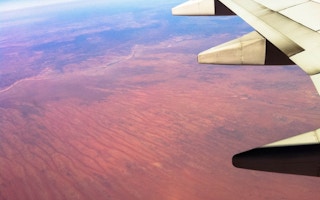In Australia, the amount of aviation fuel consumed per head of population has more than doubled since the 1980s. We now use, on average, 2.2 barrels (or 347 litres) of jet fuel per person per year.
This historically unprecedented aeromobility has enormous environmental costs. Aviation is contributing to around 4.9 per cent of current global warming and this is forecast to at least triple by 2050. Domestic aviation in Australia produces around 8.6 million tonnes of greenhouse gases each year.
Offsetting schemes, technology solutions and other attempts to lower the carbon emissions of aviation have failed dismally.
The only solution to these intractable environmental impacts is the dramatic reduction, or complete elimination, of air travel. It might be hard to imagine life without the plane, but the idea is not as crazy as it sounds.
Here are nine common objections to grounding planes, and our counterpoints:
1. There are no fast, cheap and clean transport alternatives to the plane.
So we build them. We construct a national high-speed rail network and more efficient intercity, rural and urban transport systems. These projects would involve Australian steel, thousands of new jobs and large-scale regional planning and infrastructure development.
These programs would ameliorate urban congestion, the most pressing priority of Infrastructure Australia, revitalise regional communities and dramatically reduce our imports of crude and refined petroleum.
The continual development of communications technologies, including fast internet and virtual reality, will make much business travel redundant. Investing in virtual technologies and forcing the political and corporate elite to use other transport modes would hasten political support for, and investment in, the development of transport alternatives.

Australian aviation fuel consumption per capita 1985-2015. Sources: Australian Petroleum Statistics and the ABS Estimated Residential Population.
2. What about the economic value of tourism?
If we abandoned all tourist flights, the economy would be A$14.4 billion better off. International visitors spent A$38.1 billion in Australia in 2015-16. But, Australians travelling overseas spent far more – A$52.4 billion – in the same period.
International tourism, both in and outbound, would continue under a no–aviation scenario. As an island nation we will become reliant on ships. Travel by cruise ship is already booming. While cruise ships are currently highly polluting, their conversion to non-fossil-fuel energy, in contrast to the plane, is more achievable.
3. What about our education export industry?
Transnational education, teaching of students by Australian university offshore programs and via online distance education, is already significant, accounting for 30.2 per cent of all higher education international students in 2015. We would invest more heavily in these educational platforms and technologies.
4. What about the jobs in the aviation industry?
Technological replacement and offshoring have decimated full-time jobs in Australia’s aviation industry. The employment generated by growth in domestic tourism and the construction of high-speed rail, ships and other transport alternatives would more than compensate.

Aviation jobs per 1000 revenue passenger kilometres for domestic flights. Sources: BITRE Australian Domestic Aviation Activity data and the ABS Labour Force Survey statistics on employment in the air and space transport industries.
5. What about the needs of farmers and hospitality industries who rely on backpackers?
We would still have a backpacker labour force under conditions of “slow tourism” that uses alternatives to cars and planes. Particularly for longer-stay tourism, arrival and departures by boat would be a small component of a trip.
We could also start using our own population for these jobs by paying higher wages. This might also reduce unemployment and dependency on social welfare and raise additional tax revenue. In the longer term we would transition to agriculture and hospitality industries that are not reliant on exploited and underpaid holiday-workers.
6. What about medical, military and rescue flights?
We need to keep essential flights for medical, rescue and firefighting purposes, and some military capacity. For essential flights, mitigation strategies like offsets may work as emissions would be low in aggregate.
7. What about sport and culture?
Sport and air travel are closely linked. Our national rugby union team is the Qantas Wallabies. Although teams travel, more spectators than ever are staying put – preferring to watch live sports on TV. Technological improvements will continue to produce a better-than-real home experience. And the eSports teams of the future may not have to leave home either.
8. Prohibition never works!
Banning things like alcohol has proven historically difficult, even in Canberra. But no-fly zones are easier to enforce – you couldn’t smuggle an A380 into the country and fly it around without anyone noticing.
9. It’s too radical a change – it would cause chaos!
Arguably, the controllable outcomes of grounding aircraft will be far less severe than the chaos of uncontrolled global climate change. A transformed, low-emissions transportation system can be planned for and, while there will be significant readjustment, life will go on.
A “business as usual” climate change scenario will unleash destruction unparalleled in human history, including the genuine threat of species extinction.
As an island nation we are more dependent than most on the aeroplane. Rather than giving us special dispensation, this puts us in a position to be world leaders in sustainable transport. Our proposal to ground planes and dramatically reduce emissions would need tremendous action in terms of civic will, and a state apparatus politically capable of taking radical action.
Liberal democracies are capable of such action, as evidenced by Australia’s Snowy Mountains Scheme. And Trump’s mandate to build infrastructure shows nation-building projects still command public support. An aviation-free Australia is a genuine and necessary alternative.
Martin Young is associate professor, School of Business and Tourism, Southern Cross University; Francis Markham is PhD Candidate, The Fenner School of Environment and Society, Australian National University; James Higham is professor of tourism, University of Otago, and John Jenkins is professor, School of Business and Tourism, Southern Cross University. M
This article was originally published on The Conversation.








